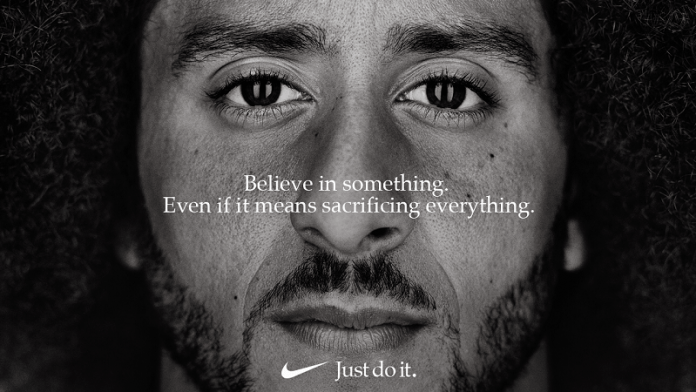By Nick Craig
Some observers see Nike’s ‘Just Do It’ campaign featuring Colin Kaepernik as a smart, calculated marketing risk with high potential rewards. Others view it as a political statement. Either way, it is clearly succeeding as either one of these things, or both.
But there’s another way to look at it, one that can inform leaders everywhere about what drives the kind of bold, risky choices that most people are reluctant to make but usually pay off many times over in profits and satisfaction–and how to get the courage to make them.
Ben & Jerry’s former CEO, Jostein Solheim, is no stranger to choosing the harder, riskier path instead of one that offers certainty and guarantees. When his head of product development proposed a new flavor based on the infamous Saturday Night Live “Shweddy Balls” skit starring Alec Baldwin, he ultimately said yes.
Launching a slightly inappropriate flavor could have snowballed, resulting in all Ben & Jerry’s flavors being pulled from shelves, negative publicity, upset customers, and more. And some of that did happen: an influential mothers’ group was very unhappy to hear their kids talking about “Schweddy Balls.” Some major retailers were displeased, and it took a while to build back the trust needed to grow the business over time.
If you asked Jostein where he found the clarity and courage to implement this counterintuitive and, some would say, outrageous, decision, he’s likely to answer: “purpose.” Having coached Jostein on the path toward discovering his purpose, I have seen this play out for him first hand, both personally and as a leader.
On an individual level, purpose describes to the essence of who we are and what we bring to a situation that nobody else can. It is present in every instant of our lives and evident in how we interact with the challenges of the moment. Purpose gives leaders the clarity of vision and the confidence to act when it is needed most. It also empowers leaders to see possibilities that others couldn’t and make tough, brave decisions. I discuss this in my book, Leading From Purpose.
Organizations have a purpose, too. Most often, it emerges from the founder’s purpose. It’s hard to think about Southwest Airlines, for example, without thinking of its iconic founder, Herb Kelleher. In the same way, we can’t separate Teach for America from Wendy Kopp, Apple from Steve Jobs, or Tata Industries from Jamshedji Tata. Making the tough but right decisions, making incredible things happen is the work of individuals, not nameless, faceless organizations. It all comes down to people like you and me living our own purpose on the stage of an organization’s compelling purpose. When a leader’s own purpose is connected to the organization’s purpose, that is powerful.
And that is just what happened with Shweddy Balls. Jostein describes his purpose as, “Helping people thrive in paradox and ambiguity for things that really matter.” Certainly, there was no shortage of paradox or ambiguity in this off-color choice of a flavor name. Ben & Jerry’s prides itself on being the company that has a sense of humor – being the crazy brand that does what others won’t do and can’t get away with. Another paradox, and more ambiguity: humor can simultaneously entertain, and offend. At the same time, Jostein was at a place in his Ben & Jerry’s career where he knew he had to demonstrate to employees that he was committed to what Ben & Jerry’s stood for. Would he step up and show that he could really live the organization’s mission and purpose? Would he cave to his bosses and to the major retailers and say, no we really are not going to be Ben & Jerry’s, or was he going to demonstrate, by doing something that was a beautiful example of this crazy, wonderful, slightly inappropriate iconic brand, that his individual and organizational purposes were aligned?
After that moment, the employees all realized that Jostein was fully in the game. Recently, Ben told Jostein that he had “out-Ben’d” him.
In the end, although Corporate America hated the flavor, consumers couldn’t get enough. Schweddy Balls became a huge marketing success for Ben & Jerry’s. Every news outlet had to
talk about it. Nobody in the 2011 Christmas season escaped without wondering what it would
taste like. The congruence and alignment between Jostein’s purpose and the brand’s have allowed Ben & Jerry’s, one of the first premium ice creams, to go from single-digit declining numbers in Jostein’s early days to double-digit growth today.
Interestingly, while purpose-driven decisions are not dictated by concerns about the bottom line, sustainable growth over time is often the fortuitous result. I’ve seen a former IBM executive create $14 million in new sales by reviving six mothballed accounts there that nobody wanted, then reopen a distribution network of about 500 new outlets, after connecting with his purpose. A Unilever Pakistan leader I’ve worked with transformed the business from serving about 100,000 shops to serving over 300,000, growing the business by 400 percent, with profits increasing by 500 percent.
While I haven’t worked with Nike, from where I’m sitting it looks like the bold choice to engage Colin Kaepernick as the face of ‘Just Do It’ was driven by a powerful convergence of individual and corporate and purpose. After all, named for the Greek goddess of victory, with a brand image that radiates empowerment even in the toughest of conditions, it only makes sense for Nike to “just do it.” Clearly its leaders are confident that they can not only stand up in the face of controversy, but thrive.
And like so many other purpose-driven decisions, the move is paying off.
Nick Craig is the Founder and President of the Core Leadership Institute, formerly the Authentic Leadership Institute.
Photo Courtesy: Nike







